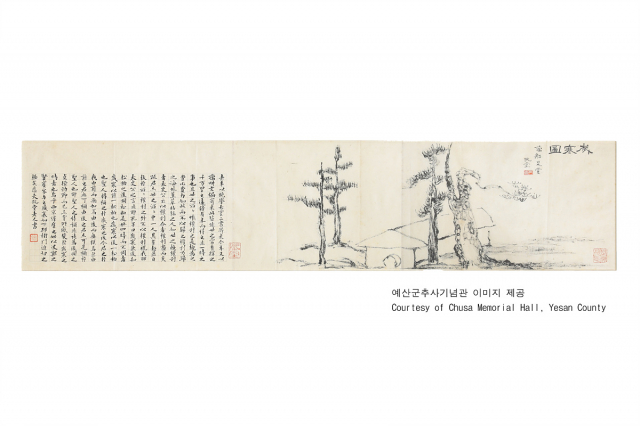
Sehando (facsimile edition by Fujitsuka Chikashi)
Chusa Kim Jeonghui
You're looking at two masterpieces by Chusa Kim Jeong-hui, Korea's greatest calligrapher and one of our most beloved scholars.
First, this simple but profound painting called "Winter Scene." The title comes from Confucius: "Only when winter comes do we know that pine and cypress trees don't wither." True character shows itself in difficult times.
This painting was born from gratitude. In 1844, while Kim Jeong-hui was exiled on Jeju Island, his student Lee Sang-jeok sent him books despite the long, dangerous journey. Moved by this loyalty, Chusa painted this as a thank-you gift.
Look at the scene: two pine trees and a simple house in barren winter landscape. No complex mountains, no people—just quiet endurance. The trees represent his student's unchanging heart; the small house shows a strong spirit surviving in isolation.
This isn't just landscape painting—it's a portrait of friendship and dignity that survives any hardship.
The calligraphy piece "Scholar's Simple Treasures" lists three things a scholar needs: the finest inkstone, bamboo tea warmer, and quiet study for poetry. This represents Chusa's philosophy—that spiritual richness matters more than material wealth.
Notice his unique calligraphy style, called "Chusa-che." It mixes ancient script styles in bold, sometimes irregular ways. Thick and seemingly neat, but with strange, flowing energy throughout. This shows an artist freed from rigid rules, reaching new creative heights in his later years.
There's a special story about how we can see this today. In the early 20th century, this painting had been taken to Japan. Master calligrapher Sojeon Son Jae-hyeong personally went to Japan and brought it back to Korea. Now it's National Treasure No. 180.
These works remind us that even in the coldest times, friendship, learning, and beauty can survive and flourish.
First, this simple but profound painting called "Winter Scene." The title comes from Confucius: "Only when winter comes do we know that pine and cypress trees don't wither." True character shows itself in difficult times.
This painting was born from gratitude. In 1844, while Kim Jeong-hui was exiled on Jeju Island, his student Lee Sang-jeok sent him books despite the long, dangerous journey. Moved by this loyalty, Chusa painted this as a thank-you gift.
Look at the scene: two pine trees and a simple house in barren winter landscape. No complex mountains, no people—just quiet endurance. The trees represent his student's unchanging heart; the small house shows a strong spirit surviving in isolation.
This isn't just landscape painting—it's a portrait of friendship and dignity that survives any hardship.
The calligraphy piece "Scholar's Simple Treasures" lists three things a scholar needs: the finest inkstone, bamboo tea warmer, and quiet study for poetry. This represents Chusa's philosophy—that spiritual richness matters more than material wealth.
Notice his unique calligraphy style, called "Chusa-che." It mixes ancient script styles in bold, sometimes irregular ways. Thick and seemingly neat, but with strange, flowing energy throughout. This shows an artist freed from rigid rules, reaching new creative heights in his later years.
There's a special story about how we can see this today. In the early 20th century, this painting had been taken to Japan. Master calligrapher Sojeon Son Jae-hyeong personally went to Japan and brought it back to Korea. Now it's National Treasure No. 180.
These works remind us that even in the coldest times, friendship, learning, and beauty can survive and flourish.
